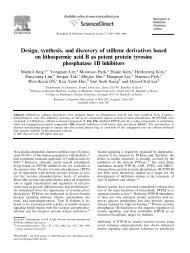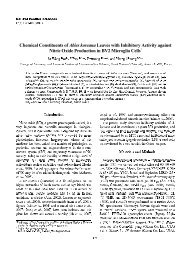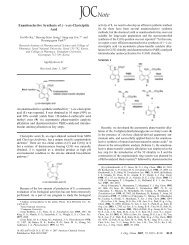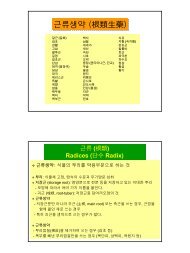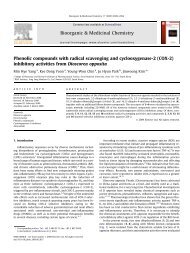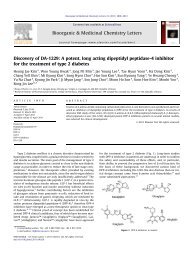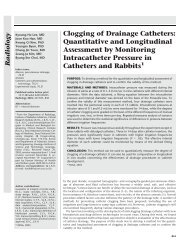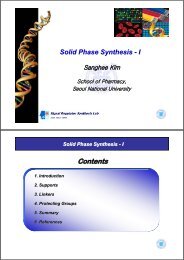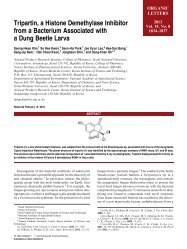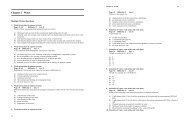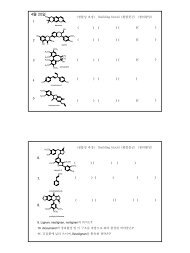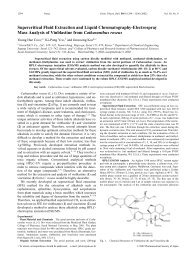Transport of anti-allergic drugs across the passage cultured human ...
Transport of anti-allergic drugs across the passage cultured human ...
Transport of anti-allergic drugs across the passage cultured human ...
Create successful ePaper yourself
Turn your PDF publications into a flip-book with our unique Google optimized e-Paper software.
210 H. Lin et al. / European Journal <strong>of</strong> Pharmaceutical Sciences 26 (2005) 203–210Bremer, S., Ho<strong>of</strong>, T., Wilke, M., Busche, R., Scholte, B., Riordan,J.R., Maass, G., Tummler, B., 1992. Qu<strong>anti</strong>tative expression patterns<strong>of</strong> multidrug-resistance P-glycoprotein (MDR1) and differentiallyspliced cystic-fibrosis transmembrane-conductance regulator mRNAtranscripts in <strong>human</strong> epi<strong>the</strong>lia. Eur. J. Biochem. 206, 137–149.Buchanan, J.A., Yeger, H., Tabcharani, J.A., Jensen, T.J., Auerbach, W.,Hanrahan, J.W., Riodan, J.R., Buchwald, M., 1990. Transformed sweatgland and nasal epi<strong>the</strong>lial cell lines from control and cystic fibrosisindividuals. J. Cell Sci. 95 (Pt. 1), 109–123.Dearden, J.C., Bresnen, G.M., 1988. The measurement <strong>of</strong> partition coefficients.Quant. Struct. Act. Relat. 7, 133–144.Elbert, K.J., Schafer, U.F., Schafers, H.J., Kim, K.J., Lee, V.H., Lehr,C.M., 1999. Monolayers <strong>of</strong> <strong>human</strong> alveolar epi<strong>the</strong>lial cells in primaryculture for pulmonary absorption and transport studies. Pharm. Res.16, 601–608.Freshney, R.I., 1994. Chapter <strong>of</strong> Media. Culture <strong>of</strong> Animal Cells: A Manual<strong>of</strong> Basic Technique, fourth Wiley-Liss Inc, pp. 99.Henriksson, G., Norlander, T., Zheng, X., Stierna, P., Westrin, K.M., 1997.Expression <strong>of</strong> p-glycoprotein 170 in nasal mucosa may be increasedwith topical steroids. Am. J. Rhinol. 11, 317–321.Huang, C.H., Kimura, R., Nassar, R.B., Hussain, A., 1985. Mechanism <strong>of</strong>nasal absorption <strong>of</strong> <strong>drugs</strong>. Part I: physicochemical parameters influencing<strong>the</strong> rate <strong>of</strong> in situ nasal absorption <strong>of</strong> <strong>drugs</strong> in rats. J. Pharm.Sci. 74, 608–611.Hussain, A.A., Hirai, S., Bawarshi, R., 1981. Nasal absorption <strong>of</strong> naturalcontraceptive steroids in rats: progesterone absorption. J. Pharm. Sci.70, 466–467.Jorissen, M., Bessems, A., 1995. Influence <strong>of</strong> culture duration and ciliogenesison <strong>the</strong> relationship between ciliary beat frequency andtemperature in nasal epi<strong>the</strong>lial cells. Eur. Arch. Otorhinolaryngol. 252,451–454.Kissel, T., Werner, U., 1998. Nasal delivery <strong>of</strong> peptides: an in vitro cellculture model for <strong>the</strong> investigation <strong>of</strong> transport and metabolism in<strong>human</strong> nasal epi<strong>the</strong>lium. J. Control. Release 53, 195–203.Krishnamoorthy, R., Mitra, A.K., 1998. Pro<strong>drugs</strong> for nasal drug delivery.Adv. Drug Deliv. Rev. 29, 135–146.Lipworth, B.J., Jackson, C.M., 2000. Safety <strong>of</strong> inhaled and intranasalcorticosteroids: lessons for <strong>the</strong> new millennium. Drug Saf. 23, 11–33.Mathias, N.R., Kim, K.J., Robison, T.W., Lee, V.H., 1995. Developmentand characterization <strong>of</strong> rabbit tracheal epi<strong>the</strong>lial cell monolayer modelsfor drug transport studies. Pharm. Res. 12, 1499–1505.Morimoto, K., Yamaguchi, H., Iwakura, Y., Miyazaki, M., Nakatani,E., Iwamoto, T., Ohashi, Y., Nakai, Y., 1991. Effects <strong>of</strong> proteolyticenzyme inhibitors on <strong>the</strong> nasal absorption <strong>of</strong> vasopressin and an analogue.Pharm. Res. 8, 1175–1179.Osth, K., Grasjo, J., Bjork, E., 2002. A new method for drug-transportstudies on pig nasal mucosa using a horizontal Ussing chamber. J.Pharm. Sci. 91, 1259–1273.Perl<strong>of</strong>f, M.D., von Moltke, L.L., Greenblatt, D.J., 2002. Fex<strong>of</strong>enadinetransport in Caco-2 cells: inhibition with verapamil and ritonavir. J.Clin. Pharmacol. 42, 1269–1274.Roh, H.J., Goh, E.K., Wang, S.G., Chon, K.M., Yoon, J.H., Kim, Y.S.,1999. Serially <strong>passage</strong>d normal <strong>human</strong> nasal epi<strong>the</strong>lial cells: morphologyand mucous secretory differentiation. Korean J. Rhinol. 6,107–112.Ruckes, C., Blank, U., Moller, K., Rieboldt, J., Lindemann, H., Munker,G., Clauss, W., Weber, W.M., 1997. Amiloride-sensitive Na+ channelsin <strong>human</strong> nasal epi<strong>the</strong>lium are different from classical epi<strong>the</strong>lial Na+channels. Biochem. Biophys. Res. Commun. 237, 488–491.Saha, P., Kim, K.J., Yamahara, H., Crandall, E.D., Lee, V.H.L., 1994.Influence <strong>of</strong> lipophilicity on -blocker permeation <strong>across</strong> rat alveolarepi<strong>the</strong>lial cell monolayers. J. Control. Release 32, 191–200.Schmidt, M.C., Peter, H., Lang, S.R., Ditzinger, G., Merkle, H.P., 1998. Invitro cell models to study nasal mucosal permeability and metabolism.Adv. Drug Deliv. Rev. 29, 51–79.Wadell, C., Bjork, E., Camber, O., 2003. Permeability <strong>of</strong> porcine nasalmucosa correlated with <strong>human</strong> nasal absorption. Eur. J. Pharm. Sci.18, 47–53.Wang, W., Sasaki, H., Chien, D.S., Lee, V.H., 1991. Lipophilicity influenceon conjunctival drug penetration in <strong>the</strong> pigmented rabbit: acomparison with corneal penetration. Curr. Eye Res. 10, 571–579.Werner, U., Kissel, T., 1995. Development <strong>of</strong> a <strong>human</strong> nasal epi<strong>the</strong>lialcell culture model and its suitability for transport and metabolismstudies under in vitro conditions. Pharm. Res. 12, 565–571.Wioland, M.A., Fleury-Feith, J., Corlieu, P., Commo, F., Monceaux, G.,Lacau-St-Guily, J., Bernaudin, J.F., 2000. CFTR, MDR1, and MRP1immunolocalization in normal <strong>human</strong> nasal respiratory mucosa. J. Histochem.Cytochem. 48, 1215–1222.Yang, J.J., Ueda, H., Kim, K., Lee, V.H., 2000. Meeting future challengesin topical ocular drug delivery: development <strong>of</strong> an air-interfaced primaryculture <strong>of</strong> rabbit conjunctival epi<strong>the</strong>lial cells on a permeablesupport for drug transport studies. J. Control. Release 65, 1–11.Yoo, J.W., Kim, Y.S., Lee, S.H., Lee, M.K., Roh, H.J., Jhun, B.H.,Lee, C.H., Kim, D.D., 2003. Serially <strong>passage</strong>d <strong>human</strong> nasal epi<strong>the</strong>lialcell monolayer for in vitro drug transport studies. Pharm. Res. 20,1690–1696.



